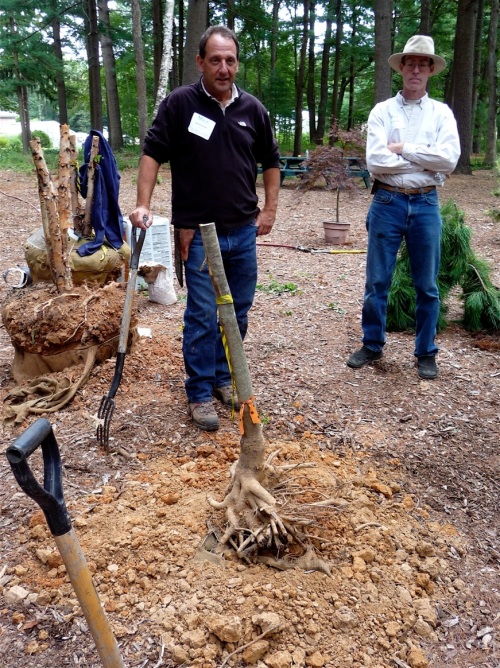At the MAA Elm Bank workshop on September 10, 2009, Matt Foti demonstrated how to address root problems at the time of planting. He had a fairly large collection of trunk-and-root masses to illustrate his points, and used them to show how girdling roots, secondary root systems, and J-rooted systems can develop as a result of poor planting or growing practices.
Matt first showed a couple of forest saplings he had pulled early in the day to illustrate how a naturally-seeded tree’s roots grow. The sapling’s roots were evenly spaced around its stem, and extended out a distance relatively equivalent to the distance its topgrowth extended from the stem.

This little forest-grown white pine has a clean, evenly spaced root system.
He then pointed to a couple of nursery-grown trees whose rooting problems had become evident after several years.

These root systems have been cut in the digging process. In an attempt to regrow roots, the foreground tree has sent out a secondary root system, several of which are beginning to girdle other roots. Kept too long in a burlapped ball or in a container, roots will often turn back in to the ball, making effective planting and long-term growth problematic.
Shrubs as well as trees are susceptible to root problems; Matt dismantled an Ilex verticillata root mass to illustrate how he treats roots bound in a container or in burlap before planting.

Fibrous roots hold together in a near solid mass right out of the container.

Using a three-pronged fork to untangle the root mass. For a bigger shrub or small tree, a machete or pitchfork may work well to loosen soil and reorient roots.

Ilex verticillata root mass, now ready for planting.
Soil can present another problem for nursery-dug B&B trees. Clay soils make sturdy root balls, which can be useful for shipping, but not so great for root growth.

This pair of trees have root masses encased in rock-hard clay soils. Note the solid clumps of clay in the foreground, and root growth only on top of the root ball -- these roots found it impossible to grow into and through this soil. Breaking up the soil in a root ball like this before planting promotes the tree's future health; leaving this kind of root ball intact almost guarantees tree stress and decline.

Closeup of rock-hard clay root ball, broken apart (fairly violently) for demonstration purposes.

Another example of a dense clay root ball that constricted root growth to the tree's great detriment. Soil had also been piled up around this tree's trunk flare, further challenging its ability to live. Tough conditions for a tree to grow in...
The point of these illustrations was to show how necessary it is, when planting a tree or shrub, to work with the root ball before covering it with soil. Removing wire baskets, removing burlap, loosening or removing the soil, untangling roots as best as possible, pruning roots when necessary — all these tactics make up a strategy for promoting real tree growth. Bare-root techniques have shown that a great deal of the work that arborists do these days is remedial — that is, is work intended to remedy poor growing, digging, or planting practices. With the knowledge arborists now have of how root issues so obviously affect plant health, it only makes sense to attend to those issues early on, to avoid greater problems later.
Demonstrating arborist at this station:
Matt Foti, Matthew R. Foti Landscape and Tree Service, Inc., Lexington, MA
Read Full Post »












